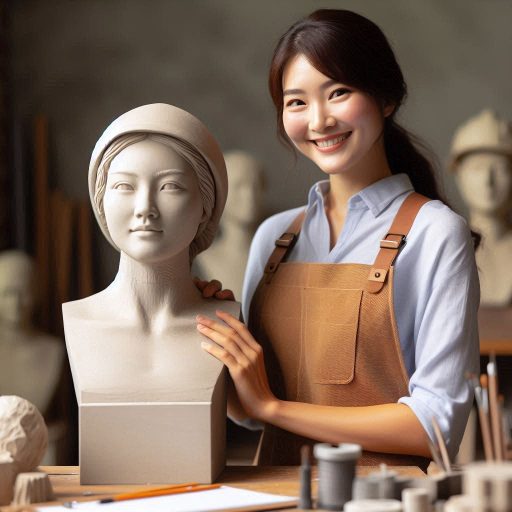Introduction
Glass art projects involve creating artistic pieces from glass through techniques like blowing, casting, and fusing.
Artists use various methods to transform raw glass into beautiful works of art, including sculptures, installations, and functional pieces.
These projects often require specialized tools, materials, and skills, making them both intricate and expensive.
Funding is crucial for artists to bring their glass art projects to life.
It supports the purchase of materials, covers studio costs, and helps fund exhibitions and promotions.
Without adequate funding, artists may struggle to complete projects or reach their target audience.
Financial support enables artists to focus on their craft rather than financial constraints.
Various funding options are available to support glass art projects.
Grants are a primary source, offered by organizations that support the arts.
These grants may be specific to glass art or general arts funding.
Crowdfunding platforms like Kickstarter and Indiegogo allow artists to raise money from a broad audience.
Social media campaigns can also help garner support and spread awareness.
Additionally, sponsorships from businesses and art institutions can provide significant financial backing.
Some artists seek commissions from private collectors or public installations to fund their work.
Art residencies often include stipends or financial support, allowing artists to work on their projects without financial stress.
Exploring and utilizing these funding options can significantly enhance an artist‘s ability to produce and showcase their glass art.
Each funding avenue presents unique opportunities and challenges, but with a strategic approach, artists can secure the necessary resources to bring their creative visions to life.
Grants: Funding Your Glass Art Projects
Grants for Artists
They are financial awards given to artists to support their creative projects.
Unlike loans, grants do not require repayment.
They are designed to foster artistic development and innovation.
Transform Your Career Today
Unlock a personalized career strategy that drives real results. Get tailored advice and a roadmap designed just for you.
Start NowArtists can use grants to fund various aspects of their projects, including materials, studio space, and marketing.
Each grant has specific eligibility requirements and application procedures.
Understanding these criteria is crucial for a successful application.
How to Find and Apply for Grants Specifically for Glass Art Projects
Finding grants for glass art requires research and strategic planning.
Start by identifying organizations that support visual arts and specifically glass art.
Use online grant databases and artist networks to discover relevant opportunities.
Tailor your application to align with the grant‘s goals and guidelines.
Highlight how your project contributes to the field of glass art and its potential impact.
Craft a compelling proposal that demonstrates your artistic vision and project feasibility.
Examples of Organizations that Offer Grants for Artists
Several organizations provide grants for glass art projects.
The Tides Foundation offers grants to innovative artistic endeavors, including glass art.
The National Endowment for the Arts (NEA) funds projects that contribute to the advancement of visual arts.
The Emerging Artists Program supports individual artists working in various mediums, including glass.
Local art councils and foundations may also offer smaller, project-specific grants.
Research these organizations‘ websites for detailed application guidelines and deadlines.
By pursuing grants, glass artists can secure necessary funding to bring their creative visions to life.
Careful research, tailored applications, and leveraging opportunities from reputable organizations are key to successful funding.
Read: Art and Design Portfolios: Creating a Standout
Crowdfunding for Glass Art Projects
Crowdfunding offers a powerful way to fund glass art projects.
Showcase Your Business Today
Reach thousands of readers actively exploring professional services. Publish your business profile and grow your audience now.
Publish NowIt connects artists with a community eager to support creative endeavors.
Understanding how to use crowdfunding effectively can turn your art vision into reality.
Overview of Crowdfunding Platforms
Crowdfunding platforms like Kickstarter, Indiegogo, and GoFundMe allow artists to raise funds from a broad audience.
Kickstarter focuses on creative projects with all-or-nothing funding.
Indiegogo offers flexible funding, which means you can keep the funds even if you don‘t meet your goal.
GoFundMe is ideal for personal causes and has no deadline pressure.
Tips for Creating a Successful Crowdfunding Campaign
- Craft a Compelling Story: Clearly explain your glass art project.
Share your passion and the story behind your work. - Set a Realistic Goal: Determine how much money you need and be transparent about costs.
A precise goal helps attract supporters. - Offer Attractive Rewards: Create rewards that appeal to backers, such as exclusive glass art pieces or behind-the-scenes content.
- Promote Your Campaign: Use social media, email newsletters, and personal networks to spread the word.
Regular updates keep backers engaged. - Engage with Your Supporters: Respond promptly to questions and show appreciation.
Building relationships encourages continued support.
Case Studies of Successful Glass Artists
One successful example is artist Laura Donefer.
She used Kickstarter to fund her “Fire and Glass” project, offering unique glass art pieces as rewards.
Her campaign exceeded its goal, thanks to her compelling story and active promotion.
Another example is the “Glowing Glass” project by artist Michael Rogers.
Through Indiegogo, he funded his innovative glass lighting sculptures by engaging backers with interactive updates and detailed progress reports.
His project not only met its funding goal but also gained media attention.
Crowdfunding can be a transformative tool for glass artists.
By choosing the right platform and following key strategies, you can turn your glass art dreams into tangible success.
Read: Glass Art Courses: What to Expect

Sponsorships
How to Approach Potential Sponsors for Glass Art Projects
Approaching potential sponsors requires a strategic plan.
Begin by identifying companies or organizations that align with your artistic vision.
Craft a compelling proposal that outlines your project‘s goals, audience, and impact.
Highlight how sponsoring your project can benefit them, such as through brand exposure or community engagement.
Tailor each proposal to address the specific interests of the sponsor.
Follow up with a personal meeting or call to discuss the opportunity further.
Benefits of Having Sponsors for Artists
Sponsorships provide several advantages for artists.
First, they offer financial support, easing the burden of material and production costs.
Sponsors also enhance credibility and increase visibility, potentially attracting more followers and clients.
They can open doors to new networks and opportunities, such as exhibitions or collaborations.
Additionally, a successful sponsorship can lead to long-term partnerships and further funding opportunities.
Examples of Successful Sponsorships for Glass Art Projects
Several glass artists have thrived with sponsorship support.
For example, artist Dale Chihuly‘s collaborations with major companies have expanded his reach and resources.
His projects, supported by corporate sponsorships, have been displayed worldwide, gaining significant media attention.
Similarly, the Pilchuck Glass School benefits from sponsorships, funding educational programs and artist residencies.
These examples show how sponsorships can elevate glass art projects, providing both financial backing and enhanced visibility.
In summary, securing sponsorships involves a thoughtful approach, showcasing mutual benefits.
Sponsors offer valuable support, opening doors for growth and visibility.
Successful examples illustrate the transformative potential of sponsorships in the glass art world.
Read: Digital Sculpting: Combining Art with Technology
Selling Artwork
Selling your glass art pieces can provide the funds needed for future projects.
Understanding effective strategies and pricing will enhance your success. Here‘s how you can approach this:
Strategies for Selling Glass Art Pieces
Start by identifying your target audience.
Know who appreciates and buys glass art.
Use social media platforms to showcase your work.
Showcase Your Business Today
Reach thousands of readers actively exploring professional services. Publish your business profile and grow your audience now.
Publish NowParticipate in art fairs and local exhibitions to reach potential buyers.
Collaborate with other artists to expand your network.
Create limited-edition pieces to create exclusivity and drive demand.
Offer custom commissions to attract a broader clientele.
Engage with local art communities to build relationships and gain visibility.
Tips for Pricing Artwork Effectively
Determine the value of your glass art by considering material costs and time invested.
Research similar artworks to understand market rates.
Avoid underpricing; set prices that reflect your skill and effort.
Include packaging and shipping costs in your pricing.
Offer tiered pricing for different levels of complexity.
Be prepared to negotiate, but maintain a minimum price to ensure profitability.
Regularly review and adjust your prices based on market trends and feedback.
Online Platforms and Galleries for Selling Glass Art
Utilize online platforms like Etsy and eBay to reach a global audience.
Create a professional website to showcase your portfolio and facilitate direct sales.
Join online art communities and forums to connect with buyers.
Consider listing your work on specialized art marketplaces like Saatchi Art or Artfinder.
Explore social media platforms like Instagram and Facebook to promote your art and engage with potential customers.
Reach out to online galleries that specialize in glass art for additional exposure.
Incorporate these strategies to sell your glass art effectively and fund future creative projects.
Use online platforms, set appropriate prices, and continually adapt your approach to maximize success.
Read: Art and Design Trends in 2024: What‘s Hot?
Artist Residencies
Benefits of artist residencies for funding glass art projects
Artist residencies offer glass artists a unique opportunity to focus solely on their craft without distractions, providing a conducive environment for artistic growth.
These programs often provide a stipend or grant to cover living expenses, materials, and other project-related costs, allowing artists to fully immerse themselves in their work.
Residencies also offer access to state-of-the-art facilities and equipment that may not be available in the artist’s own studio, enabling them to experiment and explore new techniques.
Furthermore, residencies provide artists with the chance to network and collaborate with other creative individuals, fostering a sense of community and support in the artistic community.
Additionally, participating in a residency can enhance an artist’s reputation and credibility in the art world, making them more attractive to galleries, collectors, and potential buyers.
Artist residencies provide glass artists with the time, space, resources, and support needed to realize their artistic vision and advance their practice.
How to find and apply for artist residencies
Begin your search for artist residencies by researching online databases, such as ResArtis and Alliance of Artists Communities, which list various residency programs.
Consider factors such as location, duration, facilities, stipend, and application requirements when selecting potential residencies that align with your artistic goals and needs.
Carefully review each residency’s application guidelines and deadlines, ensuring that you meet all eligibility criteria and submit a strong and cohesive application.
Prepare a comprehensive artist’s statement, portfolio of your work, and letters of recommendation that showcase your artistic talent, vision, and potential for growth.
Submit your application well in advance of the deadline to allow ample time for review and selection by the residency jury or panel.
Upon acceptance, prepare for your residency by gathering necessary materials, tools, and supplies, as well as making any travel arrangements or accommodations needed for your residency period.
During your residency, make the most of your time by fully engaging in the program, exploring new ideas, techniques, and collaborations, and building relationships with fellow artists and staff.
Upon completion of your residency, follow up with any required reporting or feedback, as well as sharing your experience and work with the broader artistic community through exhibitions, talks, or publications.
Testimonials from artists who have participated in residencies
“I had the most transformative experience during my residency, where I was able to push the boundaries of my glass art practice and connect with a supportive community of artists.” – Sarah, Glass Artist
“Participating in a residency not only provided me with the resources and time to create new work but also helped me establish valuable connections and opportunities for future collaborations.” – John, Glass Sculptor
“Being part of a residency program allowed me to step outside of my comfort zone, experiment with new techniques, and gain valuable feedback and mentorship from experienced artists in the field.” – Emily, Glass Blower
Gain More Insights: Famous Typographers: Pioneers of Modern Typography
Uncover the Details: Exhibition Design Internships: How to Find One
Showcase Your Business Today
Reach thousands of readers actively exploring professional services. Publish your business profile and grow your audience now.
Publish NowWorkshops and Classes: Generating Income for Glass Art Projects
Hosting workshops and classes can be a lucrative way to fund glass art projects.
By teaching others, you share your passion and generate revenue.
This approach not only supports your work but also builds a community around your art.
Let‘s explore how to organize and promote successful workshops.
Hosting Workshops and Classes to Generate Income
Offering workshops and classes allows you to monetize your skills and expertise.
You can set up hands-on sessions where participants learn glass art techniques.
Charge a fee for attendance and provide all necessary materials.
This way, you cover your costs and generate income.
Ensure your workshop content is valuable and engaging to attract participants.
Tips for Organizing Successful Workshops
- Plan the Curriculum: Develop a clear, structured curriculum that covers essential techniques and concepts.
Ensure it‘s suitable for your target audience‘s skill level. - Choose a Venue: Select a location that is accessible and has the required facilities.
This could be your studio, a community center, or a rented space. - Set a Schedule: Pick dates and times that work well for your audience.
Consider offering multiple sessions to accommodate different schedules. - Prepare Materials: Ensure all materials are ready before the workshop.
This includes glass, tools, and safety equipment. - Engage Participants: Create an interactive environment where participants can ask questions and practice techniques.
How to Promote Workshops and Attract Participants
- Use Social Media: Promote your workshops on platforms like Instagram and Facebook.
Share engaging content and use relevant hashtags. - Create a Website or Blog: Set up a page detailing your workshops. Include dates, prices, and registration details.
- Collaborate with Local Art Organizations: Partner with local galleries or art schools to spread the word about your workshops.
- Offer Early Bird Discounts: Provide discounts for early registration to encourage prompt sign-ups.
- Collect Testimonials: Share feedback from past participants to build credibility and attract new attendees.
By hosting and promoting workshops effectively, you can boost your glass art projects while engaging with a broader audience.
Conclusion
When it comes to funding your glass art projects, there are various options available to consider.
One popular avenue is crowdfunding, where artists can showcase their work and raise funds from supporters.‘
Another option is to seek grants or fellowships specifically designed for artists.
These opportunities can provide financial support for your projects and help you further your artistic career.‘
Artist residencies offer artists a chance to focus on their work in a dedicated space while receiving financial assistance.
This can be a great way to fund your glass art projects while also gaining new inspiration.‘
You can also fund your projects by selling your completed glass artwork.
Building a strong portfolio and marketing your pieces effectively can attract buyers and provide a source of income for future projects.
Ultimately, it’s important for artists to explore different funding avenues to ensure financial sustainability in pursuing their artistic passion.
By diversifying your funding sources, you can better support your creative endeavors and continue to grow as an artist.‘
The key to funding your glass art projects lies in exploring various options such as crowdfunding, grants, artist residencies, and selling your artwork.
Financial sustainability is crucial for artists to continue pursuing their passion and creating meaningful work.
[E-Books for Sale]
The Big Book of 500 High-Paying Jobs in America: Unlock Your Earning Potential
$19.99 • 500 High-Paying Jobs • 330 pages
Explore 500 high-paying jobs in America and learn how to boost your career, earn more, and achieve success!
See All 500 High-Paying Jobs of this E-Book
1001 Professions Without a Degree: High-Paying American Jobs You Can Start Now
$19.99 • 1001 Professions Without a Degree • 174 pages
Discover 1001 high-paying jobs without a degree! Unlock career tips, skills, and success strategies for just $19.99!




